 |
New York
Architecture Images-Brooklyn TWA Terminal Top 25 NY Buildings |
|
architect |
Eero Saarinen |
|
location |
John F. Kennedy International Airport (formerly Idlewild) |
|
date |
1962 |
|
style |
Futurist |
|
construction |
reinforced concrete |
|
type |
Utility |
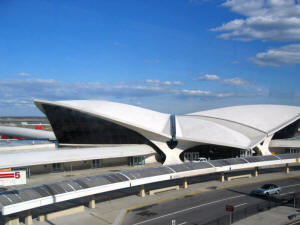 _small.jpg) _small.jpg) |
|
_small.jpg) _small.jpg) _small.jpg) |
|
_small.jpg) _small.jpg) _small.jpg) |
|
_small.jpg) _small.jpg) 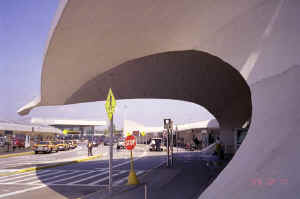 |
|
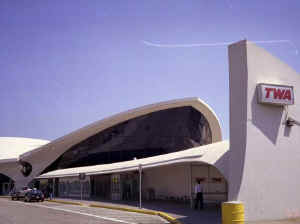 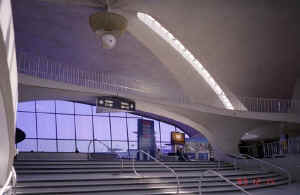 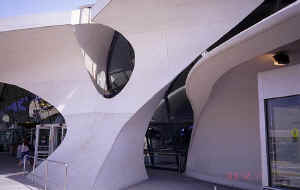 |
|
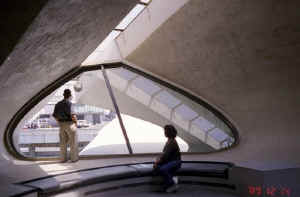 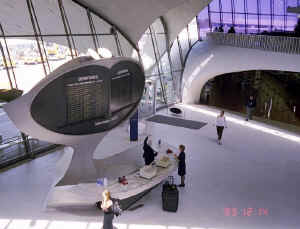 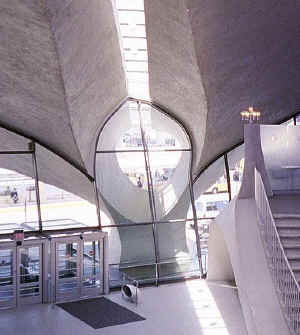 |
|
|
TWA Flight Center was the original name for the Eero Saarinen designed
Terminal 5 at Idlewild Airport — later called John F. Kennedy
International Airport — for Trans World Airlines. The terminal had a
futuristic air; The interior had wide glass windows that opened onto
parked TWA jets; departing passengers would walk to planes through
round, red-carpeted tubes. It was a far different structure and form
than Saarinen's design for the current main terminal of Washington
Dulles International Airport, which utilized mobile lounges to take
passengers to airplanes. Design of the terminal was awarded to Detroit-based Eero Saarinen and Associates. It was completed in 1962 and is the airport's most famous landmark (as well as being a National Historic Landmark). Gates in the terminal were close to the street and this made it difficult to create centralized ticketing and security checkpoints. This building was the first airline terminal to have closed circuit television, a central p/a system, baggage carousels, an electronic schedule board and precursors to the now ubiquitous baggage weigh-in scales. JFK was rare in the airport industry for having company owned and designed terminals; other airline terminals were built by Eastern Airlines and American Airlines. Individually branded terminals included the Worldport of Pan American World Airways and the Sundrome of National Airlines. Following American Airlines' buyout of TWA in 2001, Terminal 5 went out of service. The Port Authority of New York and New Jersey had proposed converting the main portion of the building into a restaurant and conference center, but some architectural critics opposed this move. In December 2005, JetBlue, which occupies the adjacent Terminal 6, began construction of an expanded terminal facility, which will utilize the front portion of Saarinen's Terminal 5 as an entry point. The peripheral air-side parts of Terminal 5 have been demolished to make space for a mostly new terminal, which will have 26 gates and is expected to be complete by 2008. The building is under restoration and expansion by JetBlue. Besides being well-known to JFK passengers and architectural buffs, it was also the site of filming of the Steven Spielberg movie Catch Me if You Can. |
|
|
Saarinen's terminal for TWA is sculpted as a
symbol of flight - abstract, and not intentionally as a landing eagle as
it has often been described. The expressive curves of the design create attractive, spacious halls and a rare degree of exhilaration for an airport terminal. The period bright orange carpets are gone, and the atmosphere is a more contemporary cool with the tone set by the purple-tinted glazing, but the romance of flight is very much alive. Although the building appears to be made of sculptural concrete, the structure is in fact braced within the concrete by an invisible web of reinforcing steel - comparable to the invisible steel hammock supporting the concrete roof of Saarinen's other 1962 airport terminal building, at Washington Dulles. '...a building in which the architecture itself would express the drama and specialness and excitement of travel... a place of movement and transition... The shapes were deliberately chosen in order to emphasize an upward-soaring quality of line. We wanted an uplift.' Eero Saarinen Saarinen died in 1961, a year before the building was completed. How to visit The TWA Terminal is numbered Terminal 5 at JFK. It is normally permanently open. The interior views on this page are visible groundside, without a flight ticket. Comprehensive practical information is at www.panynj.gov/aviation/jfkframe.HTM . Currently the terminal is closed for renovation and development, and therefore closed to visitors. "The Port Authority and United Airlines have begun work on the first phase of what ultimately will be a $1.2 billion redevelopment of Terminals 5 and 6. The first phase will be completed in 2005 and will include 15 new gates, additional ticketing and baggage areas, and a new Customs and Immigration area for international passengers at Terminal 5 – while preserving the historic Saarinen Building, perhaps the best known of Kennedy Airport’s distinctive terminals." |
|
|
"One of the most self-assured, self-confident—
even self-conscious—buildings to emerge as a result of the interplay of
the architectonic and engineer-inspired buildings was Saarinen's TWA
Terminal Buildings at New York. It alarmed the remaining purists of
modern architecture. Its bird-like symbolism, exciting forms and
cavernous interior were not simply a casual reminder of the changes that
had taken place in architectural thinking in the 1950s, but a
demonstration of the architect's role as an originator and, in the
American scene, as a 'building stylist'...Clearly it represented a
revival of architectural Expressionism..."
—Dennis Sharp. Twentieth Century Architecture: a Visual History. p245. "This is surely one of the world's most dramatic airline terminals. Few straight lines here: approached head on, its curving contours uncannily suggest a bird in flight. Inside, the main lobby's soaring, swooping walls, its carefully modeled staircases, seating areas, and many other features are a blend of graceful sculptural forms selected 'to suggest the excitement of the trip.' —from Sylvia Hart Wright. Sourcebook of Contemporary North American Architecture: From Postwar to Postmodern. p117. The Creator's Words "All the curves, all the spaces and elements right down to the shape of the signs, display boards, railings and check-in desks were to be of a matching nature. We wanted passengers passing through the building to experience a fully-designed environment, in which each part arises from another and everything belongs to the same formal world." —Eero Saarinen, 1959 from Peter Gossel and Gabriele Leuthauser. Architecture in the Twentieth Century. p250. "We should stop thinking of our individual buildings. We should take the advice my father gave me, 'Always look at the next larger thing.' When the problem is a building, we should look at the spaces and relationships that that building creates with others....In the process [the architect] will gradually formulate strong convictions about outdoor space—the beauty of the space between the buildings—and if he does, he will carry his conviction on to his most important challenge—how to build cities." — Eero Saarinen. from Allan Temko. Eero Saarinen. p26.
|
|
|
Since its completion in 1962, Eero Saarinen's
curvilinear TWA Terminal at New York's JFK International Airport has
been hailed as an icon of modern design. There's no other building like
it: Its soaring, graceful form was meant to evoke the romance and
excitement of flight, and even the smallest interior details - ticket
counters, chairs, signs, and telephone booths - were designed to
complement the gull-winged shell. But now, the Port Authority of New
York and New Jersey wants to demolish portions of the terminal and
construct a hulking new terminal behind it, leaving Saarinen's terminal
overlooked, isolated and functionally useless. One of the last works of famed designer Eero Saarinen, the TWA terminal is an irreplaceable modern icon cherished by millions of travelers and architecture buffs. In a sense, it is the mid-20th-century counterpart of earlier transportation landmarks such as Grand Central Station. The Port Authority of New York and New Jersey, owner of the building, seeks to redevelop the site as part of its airport expansion program. Current plans call for substantial demolition of the terminal's innovative flight satellite concourses, the construction of a hulking U-shaped building around its airside and a light rail system which bypasses the historic building and blocks the TWA Terminal's view of the tarmac. The Port Authority's plans will permanently remove the historic terminal's gates, and render it useless as an aviation structure. Without a stop on the new light rail system, the terminal may gradually become a White Elephant. Supporters of Saarinen's building - including hundreds of design professionals as well as preservationists - have joined civic organizations in protesting the partial demolition and calling for an alternative plan to preserve and reuse the terminal. Other airports have successfully adapted their architecturally significant buildings; if the Port Authority follows their lead, this majestic modern masterpiece can take flight again. -------------------------------- Destination Unknown Eero Saarinen’s last work, the TWA Terminal at JFK, will soon enjoy a second, temporary life as a Kunsthalle. And after that—who knows? As Cathy Lang Ho reports, the future of the modernist masterpiece is as open as the sky. Long before Santiago Calatrava unveiled his architectural allegory for flight that will become the downtown PATH station, Eero Saarinen gave New York City a symbol that captured the grace and excitement of the jet age by mimicking the shape of a soaring bird. Since its completion in 1962, the TWA Terminal at John F. Kennedy International Airport has served as an icon of both modern air travel and modern design. But its daring gull-winged construction—a reinforced concrete sculpture that tested the limits of its material and of what modernism could be—was the source of its distinction as well as downfall. The building’s stand-alone, sinewy form made it difficult to adapt it to the rapidly modernizing airline industry. Larger airplanes, increased passenger flow and automobile traffic, computerized ticketing, handicapped accessibility, and security screening are just a few of the challenges that Terminal 5 (as it’s officially known) could not meet without serious alteration. When the terminal closed in 2001 (in the wake of TWA’s demise in 1999), no other airline stepped up to take over the space. The Port Authority of New York and New Jersey (PA) did, however, receive dozens of expressions of interest from sources ranging from the Finnish government to the Municipal Art Society to the Partnership for New York City. “We expected to hear from preservationists, cultural organizations, and business people, but what surprised us was the number of requests we got from the general public—regular people, travelers—who are just deeply interested in this building,” said Ralph Tragale, manager of government and community relations for the Port Authority. One of the requests came from Rachel K. Ward, an independent curator who worked previously with the theme of tourism and the cross influences of global travel and global art in an exhibition in Switzerland. Her particular interest in tourist sites and destinations was the basis of an idea to stage a series of installations that respond to and are situated within the arch-symbol of commercial travel itself. The result, Terminal 5, presents site-specific works by 18 artists, as well as a series of lectures, events, and additional temporary installations (see sidebar), on view from October 1 to January 31. “The building is such a potent symbol, representing so many things—air travel, the 1960s, transitions, globalism,” said Ward. “Each artist had a unique response.” First lady of text messaging Jenny Holzer has, naturally, staked out the arrivals and departures board, while Ryoji Ikeda has created a series of light and sound installations for one of the tunnels. In mid-September, Vanessa Beecroft filmed a live performance piece in the terminal—her first since 2001— which will be screened in the space. Toland Grinnell, known for his penchant for luggage, will make use of the baggage claim area. “What’s exciting to me is that the artists are using the building’s forms to create works that will only exist in this space,” said Ward. Organizers are trying to arrange a shuttle service from Manhattan, and encourage the use of the new AirTrain. Wards timing was an important reason why the PA accepted her proposal. The exhibition’s run precedes a long period of construction that will not end until 2008. “The exhibition is a great opportunity to let the public enjoy the space,” said Tragale, “and to show other potential uses for it.” Plans for Terminal 5’s future have been contentious, with a battle played out publicly last year between the PA and preservationists who objected to a new terminal design concept that would have engulfed the landmark. Critics blasted the inital plan’s intent to cut off Terminal 5’s views of the runway, which motivated the design’s floor-to-ceiling windows. They also objected to the idea that it would no longer be used as a functioning terminal. At that time, Kent Barwick, the president of the Municipal Art Society, said, “By eliminating use of the terminal, you’re condemning the building to a slow death.” Even Philip Johnson, who knew Saarinen, weighed in, telling The Los Angeles Times earlier this year, “This building represents a new idea in 20th-century architecture, and yet we are willing to strangle it by enclosing it within another building. If you’re going to strangle a building to death, you may as well tear it down.” In October 2003 Jet Blue entered an agreement with the PA to expand its presence at JFK. The upstart domestic airline—the busiest at JFK, accounting for 7 million of the airport’s 30 million passengers yearly— was initially interested in the possibility of actively using the Saarinen structure but found that the cost to retrofit the relic exceeded that of building an entirely new terminal. Jet Blue commissioned Gensler and Associates to design a new terminal adjacent to Terminal 5, which, though still in concept phase, was released last month. The $850 million, 625,000-square-foot terminal is much smaller and more respectful of its site than the initial concept that so riled preservationists last year. “The sheer reduction in size makes it better, but we’re still concerned about the terminal being an active space,” said Theodore Prudon, president of DOCOMOMO-US. “If it becomes just a left-over space, it’s a disservice to the building. Also, it’s more vulnerable if it’s economically unviable.” “Terminal 5 will be used, but the question is how intensely,” said Bill Hooper, senior principal in charge of the project at Gensler. “We’re still in design development now, trying to figure out how to make as much of the original terminal work.” Gensler’s design begins with the renovation of the two tunnels that extend from the terminal to connect to waiting airplanes, known as Flight Wing Tube #1, which was part of Saarinen’s original design, and Flight Wing Tube #2, which was designed in the late 1960s by Roche Dinkeloo to support 747s that did not exist when the terminal was first built. A new plaza will occupy the space between the two terminals, allowing visitors a view, until now unseen, toward Terminal 5’s backside. Beyer Blinder Belle will oversee the structure’s restoration to its 1962 state. The process will involve undoing four decades’ worth of alterations and additions, such as new baggage rooms and a sun canopy that was attached to the façade. For its part, Jet Blue has expressed its desire to integrate the Saarinen building into its corporate image. As a result, Gensler’s design is low profile, “which reflects both its placement behind Terminal 5 and the way Jet Blue does business,” said Hooper. Jet Blue has also made the Terminal 5 exhibition possible, signing on as a major sponsor. After the exhibition closes, the PA will issue an RFP for the structure’s adaptive reuse. “We’ve heard ideas for a museum, a restaurant, a conference center,” said Tragale. “We’re open to what the business community has to offer.” Cathy Lang Ho is an editor at AN. Copyright © 2004 The Architect's Newspaper The Architect's Newspaper LLC, P.O. Box 937 • New York, NY 10013 tel. 212-966-0630 ------------------------- New York Times: October 7, 2004 Port Authority Shuts Art Exhibit In Aftermath Of Rowdy Party By CAROL VOGEL The Port Authority of New York and New Jersey has shut down an art exhibition in Terminal 5 of Kennedy Airport after a raucous opening-night party on Friday that left broken glass on the floor, graffiti on the walls and further destruction in its wake, the agency said yesterday. Pasquale DiFulco, a spokesman for the Port Authority, which operates the airport, said the curator of the show, Rachel K. Ward, had "failed to control the unlawful behavior of her guests" at the event. "We pulled the permit because the curator violated her agreement," he said. Besides smoking in the building and defacing the walls with graffiti, some guests broke a door leading to a runway, Mr. DiFulco said. Liquor was being sold at the party without a permit, he added, and Ms. Ward failed to maintain the space to "an acceptable level of cleanliness." Vomit and broken glass were on the terminal's floor, he said. Ms. Ward, who acknowledged that the crowd had exceeded her expectations - hundreds of people showed up - said she ended the party around 11 p.m., an hour earlier than planned. "We have not had an opportunity to respond to these allegations," Ms. Ward said of the authority's decision to close the show. "My lawyers are in negotiations. We want to keep the exhibition open as originally planned." The show, an exhibition of contemporary installations, by nearly 20 artists, on the theme of airports and modern travel, was to have run through Jan. 31. Terminal 5, Eero Saarinen's 1962 landmark building, was home to T.W.A. until it was closed as a passenger terminal in 2001. It has mostly been vacant since, although Steven Spielberg used it in scenes for his movie "Catch Me If You Can." "I've been working on this for a year and am looking for a resolution," said Ms. Ward, 27. "The point is to give the public access to this landmark." The terminal closed the show at noon on Tuesday. Ms. Ward said she sent a letter to the Port Authority indicating her willingness to work on any suggested changes to enable the show to continue. But the agency seemed unlikely to reverse its decision. "The permit was pulled, and that's where we stand," Mr. DiFulco said. Jet Blue, which together with the Port Authority is planning to build a terminal behind Terminal 5 that will be linked to the Saarinen building, was one of the show's biggest sponsors, donating more than $100,000. "Everyone at Jet Blue is crushed, although we support the Port Authority's decision," said Gareth Edmondson-Jones, a spokesman for the airline. "We've been working for months to make this a special event for New Yorkers which has now been spoiled because of a curator's poor management and lack of respect for the Saarinen building. "It was a chance to showcase art in a landmark terminal which had been closed for the last three years." The exhibition was meant to respond to the building's biomorphic design and original purpose. L.E.D. text messages by Jenny Holzer were installed on the arrivals-and-departures board. The Japanese sound artist Ryoji Ikeda used a tunneled walkway as a sound-and-light installation. Some works played off the items one would find in an airport. The sculptor Tom Sachs created a McDonald's sign made of foam core with Japanese characters. Another sculptor, Toland Grinnell, exhibited two of his ostentatiously customized trunks near one of the terminal's baggage claims. A photograph by Richard Prince based on the Marlboro Man ad was displayed next to a real ad for the cigarette. Even before the exhibition was installed there was trouble. The Italian artist Vanessa Beecroft was to have exhibited photographs and a video of a performance held in the terminal for a private audience. Her work, "VB54," featured 36 young women standing in formation in the sunken waiting area, wearing only Afro wigs, black body paint and silver shackles on their ankles. After the work was previewed at a private reception on Sept. 28, officials at JetBlue asked that "VB54" be removed from the show. They said that Ms. Ward had violated an agreement to let the airline review all artwork before the exhibition opened. "It was clearly a publicity ploy," said Mr. Edmondson-Jones. "They wanted it to seem like we were censoring the art when that wasn't the case at all. It had nothing to do with the content. They hadn't followed their own rules." Asked about the dispute, Ms. Ward said she could not comment. Roberta Smith contributed reporting for this article. 2004, The New York Times |
|
|
A Move to Make a Silent Air Terminal Hum
Again By DAVID W. DUNLAP Published: November 16, 2006 NYT THE Port Authority is seeking an earthbound second life for what may be the nation’s most romantic evocation of flight: Eero Saarinen’s landmark Trans World Airlines terminal at Kennedy International Airport. A Terminal Prepares to Hum Again Although its swooping forms amount to a three-dimensional transcription of “Come Fly With Me,” the building’s days as a functioning terminal were numbered in 2001 with the collapse of T.W.A. Designed in the day of the Lockheed Constellation and strained almost to bursting by the Boeing 747 and its jumbo successors, the 44-year-old building now stands empty, idle and obsolete. Restaurant? Lounge? Spa? Shopping mall? Conference center? Museum? Theater? Botanical garden? Sculpture court? Office space? A mixture? The Port Authority of New York and New Jersey is open to these ideas and “anything else that can be imagined by a redeveloper,” said its aviation director, William R. DeCota. By Nov. 30, the authority will formally request proposals from developers interested in renting the building for 25 years or more, renovating it and adapting it to new uses. Directly behind the landmark, JetBlue Airways is constructing a new Terminal 5, which is to open in 2008. The buildings will be connected through the dreamlike tubular corridors — featured evocatively in the 2002 film “Catch Me If You Can” — that once led to T.W.A.’s gates. Two electronic ticketing and check-in kiosks will be installed in the Saarinen building, so that passengers who choose to do so will still be able to go through its soaring spaces on the way to their planes. But something besides two kiosks must fill the 60,000-square-foot main hall, which sits under the vaulted juncture of the four curving concrete lobes that give the building its birdlike silhouette. Something must fill the galleries that once housed the Ambassador Club, the Paris Cafe and the Lisbon Lounge. “It isn’t just important to save the old Saarinen terminal and its phenomenal architecture,” Mr. DeCota said. “It’s important to find a thriving use. How can you continue to make this a centerpiece?” Mr. DeCota said he believed the audience was there, beginning with the 50 million travelers who are projected to pass through Kennedy in 2015 and the 40,000 employees who work there. JetBlue’s terminal will have a capacity of 20 million passengers a year. Development proposals will be due in four months. Mr. DeCota said he expected to be able to recommend a proposal to the Port Authority board by July. He said the developer would be responsible for renovating the terminal (this includes asbestos removal), restoring historical elements to “strict maintenance and preservation guidelines,” undoing recent alterations, adapting the building in a “minimally intrusive manner,” finding tenants and operating the new center — whatever it turns out to be. Perhaps the principal model is the commercial redevelopment of Union Station in Washington. The Municipal Art Society, a civic group that has been working with the Port Authority on ways to revive the Saarinen building, believes that issuing a request for proposals is an “extremely flawed” approach, said Frank E. Sanchis III, the senior vice president, not least because it means the JetBlue terminal will open before the renovation project is complete. Mr. Sanchis said the society favored keeping the Saarinen building in aviation use. He said the authority should have negotiated with JetBlue to undertake both the renovation and the new construction. Failing that, Mr. Sanchis said, the authority should have committed itself to renovating the Saarinen building and delivering it to a developer already structurally refurbished and cleared of asbestos. As it is now, he said, prospective developers may find the project too daunting. In response, Pasquale DiFulco, a spokesman for the authority, said: “Neither the Port Authority nor JetBlue is experienced in redeveloping and retenanting a building on this scale. We’re looking to bring in the experts who are best suited to do this.” JetBlue’s vice president for redevelopment, Richard J. Smyth, said being the sole tenant of the Saarinen building would not have worked operationally or financially for the airline. “More and more of our customers are checking in at home,” he said. “The whole ticketing hall experience is not what it used to be.” Nonetheless, he said he was not immune to the romance of the old terminal and would welcome the trend if JetBlue passengers chose to make the 150-yard detour to experience Saarinen’s architecture. So the two ticket kiosks may be just a start. “If there’s enough demand,” Mr. Smyth said, “I’ll put 20 in.” Copyright NYT |
|
|
links |
|